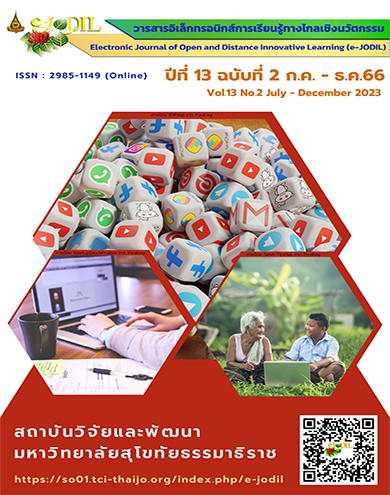Students’ Perceptions towards Learning Business Content Through English Medium Instruction: EMI
Main Article Content
บทคัดย่อ
English medium instruction (EMI) is the use of English language to teach academic subjects where the first language of students is not English. This study was conducted by obtaining students ‘perspective of attending business lectures that were conducted in English by foreign guest speakers at a public university. The objective was to study students’ perceptions towards learning business content through EMI. This research is quantitative research using a sample group consisting of 400 students in the EMI-applied business courses. The data collection tool was questionnaire. The results revealed that the majority of the respondents are willing to attend EMI business lecturers. In addition, the students perceived they have gained new knowledge in an international perspective as well as having the opportunity to practice their English. It was found that there was no significant difference between male and female students’ perception. In addition, 94 percent of the students had preference to attend more lectures in English and suggested to continue the activity into the future.
Downloads
Article Details

อนุญาตภายใต้เงื่อนไข Creative Commons Attribution-NonCommercial-NoDerivatives 4.0 International License.
บทความ ข้อความ ภาพประกอบ ตารางประกอบ ที่ตีพิมพ์ในวารสารเป็นความคิดเห็นและความรับผิดชอบของผู้เขียนแต่เพียงผู้เดียว ไม่เกี่ยวข้องกับมหาวิทยาลัยสุโขทัยธรรมาธิราชแต่อย่างใด
บทความที่เสนอพิจารณาในวารสาร e-JODIL ต้องเป็นบทความที่ไม่เคยส่งไปลงพิมพ์ เผยแพร่ หรืออยู่ระหว่างการพิจารณาของวารสารอื่น
กองบรรณาธิการขอสงวนสิทธิ์ในการพิจารณาและตัดสินการตีพิมพ์บทความในวารสาร
เอกสารอ้างอิง
Airey, J. (2011). The Disciplinary Literacy Discussion Matrix: A Heuristic Tool for Initiating Collaboration in Higher Education. Across the Disciplines, 8(3). Retrieved from https://wac.colostate.edu/docs/atd/clil/airey.cfm.
Airey, J. (2020). The Content Lecturer and English-medium Instruction (EMI): Epilogue to the Special Issue on EMI in Higher Education. International Journal of Bilingual Education and Bilingualism, 23(3), 340-346.
Brinton, D., Snow, M. A., & Wesche, M. B. (2003). Content-based Second Language Instruction. Ann Arbor: University of Michigan Press.
Coleman, J. A. (2006). English-Medium Teaching in European Higher Education. Language Teaching, 39(1), 1–14.
EF English Proficiency Index. (2022). The World’s Largest Ranking of Countries and Regions by English Skills. Retrieved from https://www.ef.com/wwen/epi/.
Hand, L., & Rowe, M. (2001). Evaluation of Student Feedback. Accounting Education, 10(2), 147–160.
Hengsadeekul, C., Koul, R., & Kaewkuekool, S. (2014). Motivational Orientation and Preference for English-medium Programs in Thailand. International Journal of Educational Research, 66, 35–44.
Li, L. (2020). Student Perceptions of the Teaching of Principles of Management Using English-Medium Instruction. Journal of Education for Business, 95(2), 115-120.
Kibuacha, F. (2021). How to Determine Sample Size for a Research Study. Retrieved from https://www.geopoll.com/blog/sample-size-research.
Macaro, E. (2020). Exploring the Role of Language in English Medium Instruction. International Journal of Bilingual Education and Bilingualism, 23(3), 263-276.
Macaro, E., & Akincioglu, M. (2018). Turkish University Students’ Perceptions About English Medium Instruction: Exploring Year Group, Gender and University Type as Variables. Journal of Multilingual and Multicultural Development, 39(3), 256-270.
Macaro, E., Curle, S., An, J., Pun, J., & Dearden, J. (2018). A Systematic Review of English Medium Instruction in Higher Education. Language Teaching, 51(1), 36–76.
MacFarlane, R. (2020). Five English-Language Skills You Should Master in Preparation for a Global Career. Insider Guides. Retrieved from https://insiderguides.com.au/importance-of-english-career/
Mandouit, L. (2018). Using Student Feedback to Improve Teaching. Educational Action Research, 26(5), 755-769.
Pritasari, A., Reinaldo, H., &. Watson, C.W. (2019). English-medium Instruction in Asian Business Schools: A Case Study. Journal of Multilingual and Multicultural Development, 40(1), 1-13.
Rovinelli, R. J., & Hambleton, R. K. (1977). On the Use of Content Specialists in the Assessment of Criterion-Referenced Test Item Validity. Tijdschrift voor Onderwijsresearch, 2(2), 49–60.
Rose, H., Curle, S., Aizawa, I., & Thompson, G. (2020). What Drives Success in English Medium Taught Courses? The Interplay Between Language Proficiency, Academic Skills, and Motivation. Studies in Higher Education, 45(11), 2149–2161.
Shohamy, E. (2012). A Critical Perspective on the Use of English as a Medium of Instruction at Universities. In A. Doiz, D. Lasagabaster and J. M. Sierra (Eds.), English-Medium Instruction at Universities: Global Challenges, (pp. 196–213). London: Longman.
Smit, U., & Dafouz, E. (2012). Integrating Content and Language in Higher Education: An Introduction to English-Medium Policies, Conceptual Issues and Research Practices Across Europe. AILA Review, 25, 1–12.
Sunderland, J. (2000). Issues of Language and Gender in Second and Foreign Language Education. Language Teaching, 33, 203–223.
Thompson, G., Takezawa, N., & Rose, H. (2022). Investigating Self-beliefs and Success for English Medium Instruction Learners Studying Finance. Journal of Education for Business, 97(4), 220-227.
Tirakanant, S. (2012). Research Methodology in Social Sciences: A Guide to Practice. Bangkok: Chulalongkorn University Press.
World Bank. (2022). Overview. Retrieved from https://www.worldbank.org/en/country/thailand/overview.


